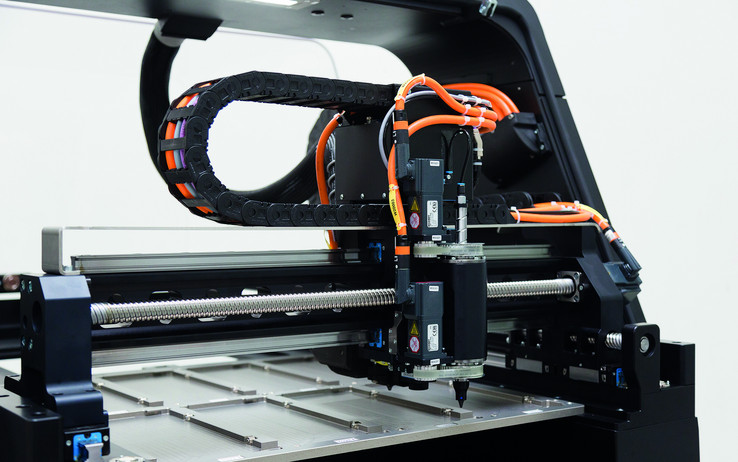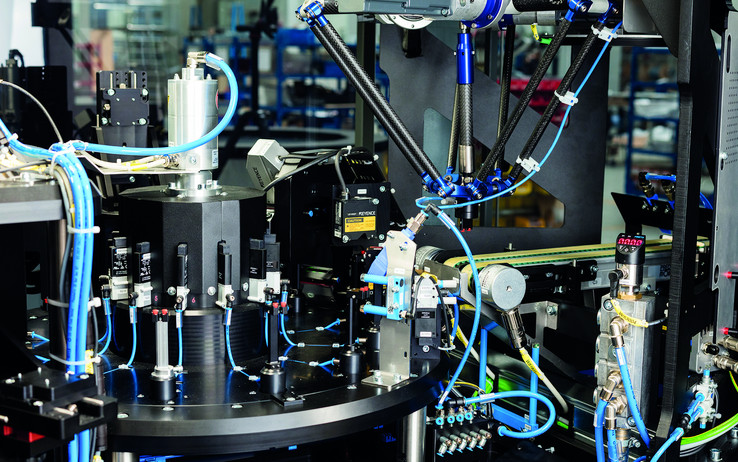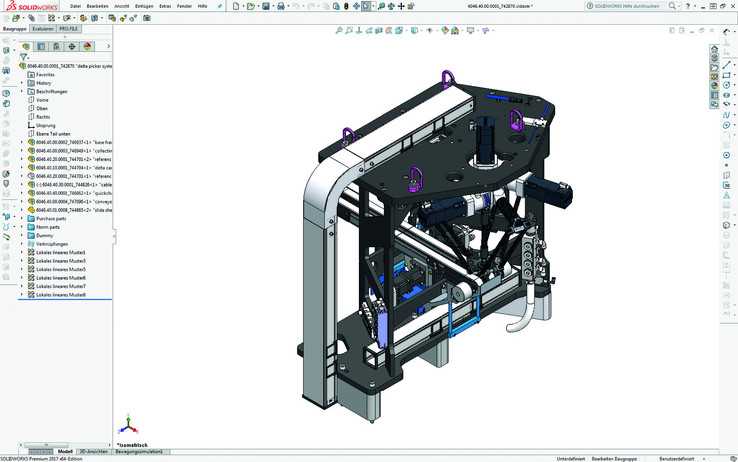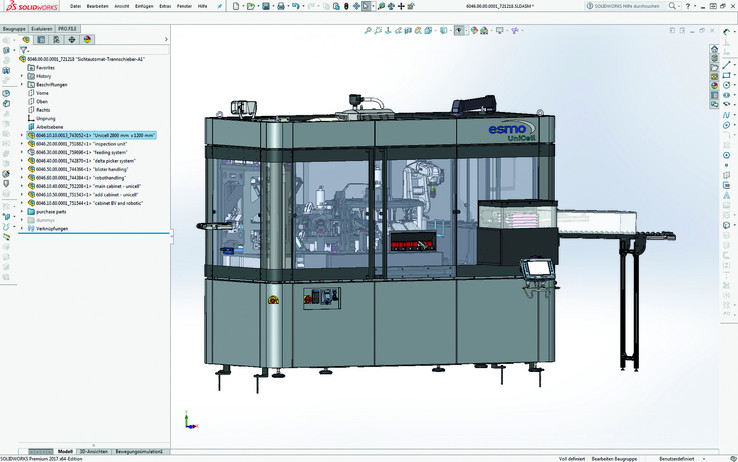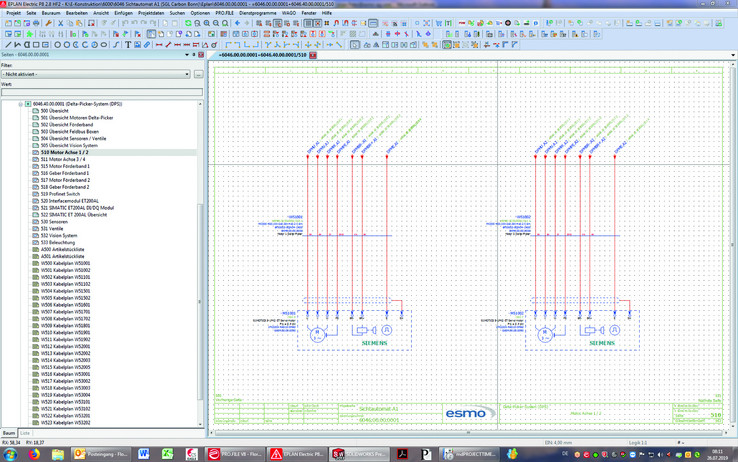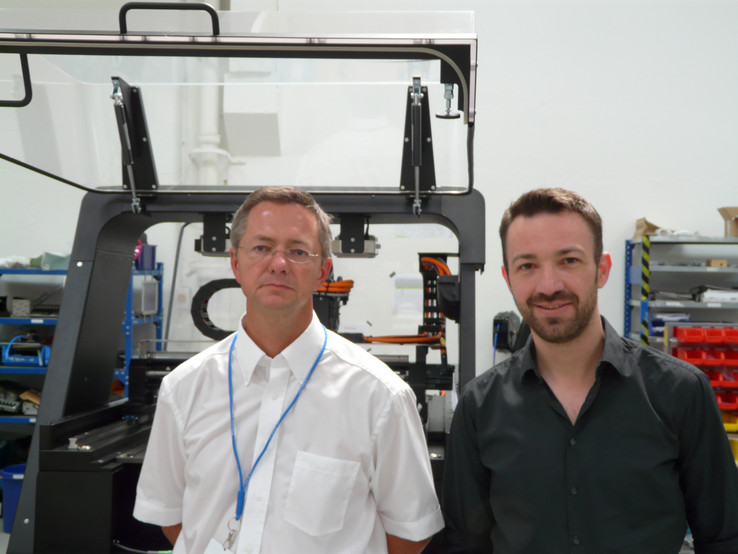Esmo simplifies product development with a mechatronic bill of materials
ECAD and MCAD linked via PDM
Esmo AG, a highly specialised manufacturer of custom machines and equipment for all industries as well as test and handling systems and equipment for the semiconductor industry, has combined data from mechanical and electrical design in a pilot project involving EPLAN and CIDEON. A mechatronic bill of materials brings considerable advantages ‒ not only in the design of complex systems.
To follow the sequence of movements of an Esmo AG test system in operation requires a lot of effort because index times can be – depending on the application – 0.6 seconds. In this short time, components to be tested are connected and tested for their electrical, optical, thermal and other testable properties. The German-based company plans the production of its own test systems as well as the integration of these into existing installations and equipment.
Broad range of skills in automation technology
Esmo automation has a broad range of expertise: from image processing (for optical 3D inspection) and the complete testing and handling of parts through to loading/feeding systems and integration into production lines. For the latter specialisms, the company established a separate business unit, Esmo automation (automation technology), in 2011, aiming also to enter new business areas. This objective has been achieved which has also increased Esmo’s independency from the cyclical and volatile nature of business in the semiconductor industry. At the same time, automation needs are becoming increasingly broader with automation systems always custom designed and manufactured. This means that control cabinet planning, procurement and production is also becoming more complex.
Objective: To link mechanical and electrical design
The above circumstances gave rise to a wish to simplify the processes in the planning department. Florian Peter, administrator in the electrical planning department: "We work with function assemblies which are sub-assemblies of a complete system. A function assembly contains components such as sensors and electric motors which are shown in both the mechanical and electrical plans". Synchronisation between the mechanical and electrical disciplines, or in other words between Solidworks and EPLAN, had only been possible manually: "Individual assemblies in our systems can contain up to 500 mechatronic components. Synchronising bills of material using Excel lists therefore often took several days. When users wanted a 'last minute change', the lists had to be manually updated and synchronised. Errors could easily occur in all the above steps and inconsistencies overlooked".
PDM made the link
The objective was therefore obvious: The two disciplines needed to be automatically linked as well as connected to the ERP system for commercial functions (purchasing, production planning, etc.).
The necessary conditions had already been established by installation of the PDM system Pro.File from PROCAD. Peter Herr: "We therefore had a platform to merge the data from the two disciplines". But the information needed from MCAD and ECAD was not yet linked. This happened only with installation of the "EPLAN Pro.File-Connector".
Result: Consistent data
This interface adds ECAD-specific data to the product models in the PDM system, e.g. connection lists, schematics and bills of materials. This then achieves a consistency of data so when, for example, a sensor or an electric motor is replaced in the mechanical plan, the change is visible in a web report created in Pro.File.
It sounds quite simple and in practice it is, and that was the objective. However, practice also shows that implementation is not always easy because the interface is highly complex. At Esmo the conditions were ideal, as a joint workshop with EPLAN and CIDEON revealed. The client had already achieved similar structures in MCAD and ECAD. Peter Herr: "We developed the concept and implementation strategy ourselves. We were able to use the standard version of the Pro.File Connector with the workshops and interface implementation being professionally carried out by a team made up of CIDEON, EPLAN and PROCAD"
Inconsistencies displayed
What does the interplay between the planning disciplines look like in practice? Planning at Esmo involves (relatively large) function assemblies. The electrical bill of materials for each assembly is transferred from EPLAN to Pro.File via the Connector. The PDM system automatically matches the data with Solidworks and provides a list of any inconsistencies. Florian Peter: "We manually check the inconsistencies and correct any errors. This task is fairly straightforward".
Result: A mechatronic bill of materials
The advantages go beyond automatic matching and consistent planning data in a single mechatronic bill of materials. Peter Herr: "The data generated in EPLAN and in Solidworks are merged not only in Pro.File. It's also available – via Pro.File – in our ERP system and is easy to access there. This is important for sales, for example".
The Esmo planners have therefore achieved their objective. Some of the benefits of the mechatronic bill of materials have become apparent only now in operations. For example, assemblies for existing machines that the customer has ordered as a repair part can be rebuilt much easier because there is only one CAD data record and not two.
Summary: Breaking new ground is worthwhile
With its mechatronic bill of materials, Esmo has broken new ground. Hardly any other company in the CAD field are able to offer such a tool in this form. As shown above, the benefits are big compared to the little effort required. One reason for this is certainly Esmo's highly advanced CAx-supported planning and its high-level of IT expertise. The example presented here may encourage other CAD users to follow the same path and check whether an interface between ECAD and MCAD (via PDM) is feasible. If so, the logical consequence is to start a project. The mechatronic bill of materials as a central data platform really does improve planning, saves time and increases quality.
Esmo AG, a highly specialised manufacturer of custom machines and equipment for all industries as well as test and handling systems and equipment for the semiconductor industry, has combined data from mechanical and electrical design in a pilot project involving EPLAN and CIDEON. A mechatronic bill of materials brings considerable advantages ‒ not only in the design of complex systems.
To follow the sequence of movements of an Esmo AG test system in operation requires a lot of effort because index times can be – depending on the application – 0.6 seconds. In this short time, components to be tested are connected and tested for their electrical, optical, thermal and other testable properties. The German-based company plans the production of its own test systems as well as the integration of these into existing installations and equipment.
Broad range of skills in automation technology
Esmo automation has a broad range of expertise: from image processing (for optical 3D inspection) and the complete testing and handling of parts through to loading/feeding systems and integration into production lines. For the latter specialisms, the company established a separate business unit, Esmo automation (automation technology), in 2011, aiming also to enter new business areas. This objective has been achieved which has also increased Esmo’s independency from the cyclical and volatile nature of business in the semiconductor industry. At the same time, automation needs are becoming increasingly broader with automation systems always custom designed and manufactured. This means that control cabinet planning, procurement and production is also becoming more complex.
Objective: To link mechanical and electrical design
The above circumstances gave rise to a wish to simplify the processes in the planning department. Florian Peter, administrator in the electrical planning department: "We work with function assemblies which are sub-assemblies of a complete system. A function assembly contains components such as sensors and electric motors which are shown in both the mechanical and electrical plans". Synchronisation between the mechanical and electrical disciplines, or in other words between Solidworks and EPLAN, had only been possible manually: "Individual assemblies in our systems can contain up to 500 mechatronic components. Synchronising bills of material using Excel lists therefore often took several days. When users wanted a 'last minute change', the lists had to be manually updated and synchronised. Errors could easily occur in all the above steps and inconsistencies overlooked".
PDM made the link
The objective was therefore obvious: The two disciplines needed to be automatically linked as well as connected to the ERP system for commercial functions (purchasing, production planning, etc.).
The necessary conditions had already been established by installation of the PDM system Pro.File from PROCAD. Peter Herr: "We therefore had a platform to merge the data from the two disciplines". But the information needed from MCAD and ECAD was not yet linked. This happened only with installation of the "EPLAN Pro.File-Connector".
Result: Consistent data
This interface adds ECAD-specific data to the product models in the PDM system, e.g. connection lists, schematics and bills of materials. This then achieves a consistency of data so when, for example, a sensor or an electric motor is replaced in the mechanical plan, the change is visible in a web report created in Pro.File.
It sounds quite simple and in practice it is, and that was the objective. However, practice also shows that implementation is not always easy because the interface is highly complex. At Esmo the conditions were ideal, as a joint workshop with EPLAN and CIDEON revealed. The client had already achieved similar structures in MCAD and ECAD. Peter Herr: "We developed the concept and implementation strategy ourselves. We were able to use the standard version of the Pro.File Connector with the workshops and interface implementation being professionally carried out by a team made up of CIDEON, EPLAN and PROCAD"
Inconsistencies displayed
What does the interplay between the planning disciplines look like in practice? Planning at Esmo involves (relatively large) function assemblies. The electrical bill of materials for each assembly is transferred from EPLAN to Pro.File via the Connector. The PDM system automatically matches the data with Solidworks and provides a list of any inconsistencies. Florian Peter: "We manually check the inconsistencies and correct any errors. This task is fairly straightforward".
Result: A mechatronic bill of materials
The advantages go beyond automatic matching and consistent planning data in a single mechatronic bill of materials. Peter Herr: "The data generated in EPLAN and in Solidworks are merged not only in Pro.File. It's also available – via Pro.File – in our ERP system and is easy to access there. This is important for sales, for example".
The Esmo planners have therefore achieved their objective. Some of the benefits of the mechatronic bill of materials have become apparent only now in operations. For example, assemblies for existing machines that the customer has ordered as a repair part can be rebuilt much easier because there is only one CAD data record and not two.
Summary: Breaking new ground is worthwhile
With its mechatronic bill of materials, Esmo has broken new ground. Hardly any other company in the CAD field are able to offer such a tool in this form. As shown above, the benefits are big compared to the little effort required. One reason for this is certainly Esmo's highly advanced CAx-supported planning and its high-level of IT expertise. The example presented here may encourage other CAD users to follow the same path and check whether an interface between ECAD and MCAD (via PDM) is feasible. If so, the logical consequence is to start a project. The mechatronic bill of materials as a central data platform really does improve planning, saves time and increases quality.



